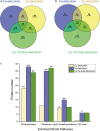Reciprocal Effect of Copper and Iron Regulation on the Proteome of Synechocystis sp. PCC 6803
- PMID: 34041232
- PMCID: PMC8141849
- DOI: 10.3389/fbioe.2021.673402
Reciprocal Effect of Copper and Iron Regulation on the Proteome of Synechocystis sp. PCC 6803
Abstract
Cyanobacteria can acclimate to changing copper and iron concentrations in the environment via metal homeostasis, but a general mechanism for interpreting their dynamic relationships is sparse. In this study, we assessed growth and chlorophyll fluorescence of Synechocystis sp. PCC 6803 and investigated proteomic responses to copper and iron deductions. Results showed that copper and iron exerted reciprocal effect on the growth and photosynthesis of Synechocystis sp. PCC 6803 at combinations of different concentrations. And some proteins involved in the uptake of copper and iron and the photosynthetic electron transport system exhibit Cu-Fe proteomic association. The protein abundance under copper and iron deduction affected the photosynthetic electronic activity of Synechocystis sp. PCC 6803 and eventually affected the growth and photosynthesis. Based on these results, we hypothesize that the Cu-Fe proteomic association of Synechocystis sp. PCC 6803 can be elucidated via the uptake system of outer membrane-periplasmic space-inner plasma membrane-thylakoid membrane, and this association is mainly required to maintain electron transfer. This study provides a broader view regarding the proteomic association between Cu and Fe in cyanobacteria, which will shed light on the role of these two metal elements in cyanobacterial energy metabolism and biomass accumulation.
Keywords: copper; cyanobacteria; deduction; iron; proteome.
Copyright © 2021 Zhen, Qin, Ren, Wang, Ma and Wang.
Conflict of interest statement
The authors declare that the research was conducted in the absence of any commercial or financial relationships that could be construed as a potential conflict of interest.
Figures




Similar articles
-
A proteomic approach to iron and copper homeostasis in cyanobacteria.Brief Funct Genomic Proteomic. 2007 Dec;6(4):322-9. doi: 10.1093/bfgp/elm030. Epub 2008 Jan 11. Brief Funct Genomic Proteomic. 2007. PMID: 18192321 Review.
-
Outer Membrane Iron Uptake Pathways in the Model Cyanobacterium Synechocystis sp. Strain PCC 6803.Appl Environ Microbiol. 2018 Sep 17;84(19):e01512-18. doi: 10.1128/AEM.01512-18. Print 2018 Oct 1. Appl Environ Microbiol. 2018. PMID: 30076192 Free PMC article.
-
Proteomic pattern alterations of the cyanobacterium Synechocystis sp. PCC 6803 in response to cadmium, nickel and cobalt.J Proteomics. 2014 May 6;102:98-112. doi: 10.1016/j.jprot.2014.03.002. Epub 2014 Mar 17. J Proteomics. 2014. PMID: 24650429
-
Inactivation of iron-sulfur cluster biogenesis regulator SufR in Synechocystis sp. PCC 6803 induces unique iron-dependent protein-level responses.Biochim Biophys Acta Gen Subj. 2017 May;1861(5 Pt A):1085-1098. doi: 10.1016/j.bbagen.2017.02.020. Epub 2017 Feb 16. Biochim Biophys Acta Gen Subj. 2017. PMID: 28216046
-
Current knowledge and recent advances in understanding metabolism of the model cyanobacterium Synechocystis sp. PCC 6803.Biosci Rep. 2020 Apr 30;40(4):BSR20193325. doi: 10.1042/BSR20193325. Biosci Rep. 2020. PMID: 32149336 Free PMC article. Review.
Cited by
-
Arthrospira platensis as Bioremediator of Rhenium Mono- and Polymetallic Synthetic Effluents.Microorganisms. 2022 Oct 26;10(11):2109. doi: 10.3390/microorganisms10112109. Microorganisms. 2022. PMID: 36363702 Free PMC article.
-
Metabolic Responses, Uptake, and Export of Copper in Cyanobacteria.Biology (Basel). 2025 Jul 1;14(7):798. doi: 10.3390/biology14070798. Biology (Basel). 2025. PMID: 40723357 Free PMC article. Review.
-
Decoding Lusichelins A-E: An In-Depth Look at the Metallophores of Lusitaniella coriacea LEGE 07167-Structure, Production, and Functionality.J Nat Prod. 2025 Jun 27;88(6):1319-1333. doi: 10.1021/acs.jnatprod.5c00204. Epub 2025 May 21. J Nat Prod. 2025. PMID: 40398867 Free PMC article.
References
LinkOut - more resources
Full Text Sources
Other Literature Sources

